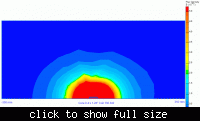miskol
Member level 4

Hi,
i want to produce electromagnetic wave in a range around 20 cm where a hall sensor will be used to detect the signal and produce voltage readings.
my current plan is to used a microcontroller to provide the pulse to a transistor circuit that will provide the high-amp pulse (up to 8 amp as supported by the inductor) to the inductor. please advise on my progress.
i am also still finding the mathematical equation that can be used to estimate the coverage area of the electromagnetic wave. if anyone could help show me the way i would be delightful.
Thank you.
i want to produce electromagnetic wave in a range around 20 cm where a hall sensor will be used to detect the signal and produce voltage readings.
my current plan is to used a microcontroller to provide the pulse to a transistor circuit that will provide the high-amp pulse (up to 8 amp as supported by the inductor) to the inductor. please advise on my progress.
i am also still finding the mathematical equation that can be used to estimate the coverage area of the electromagnetic wave. if anyone could help show me the way i would be delightful.
Thank you.




